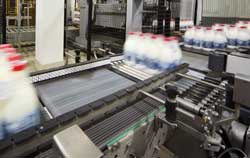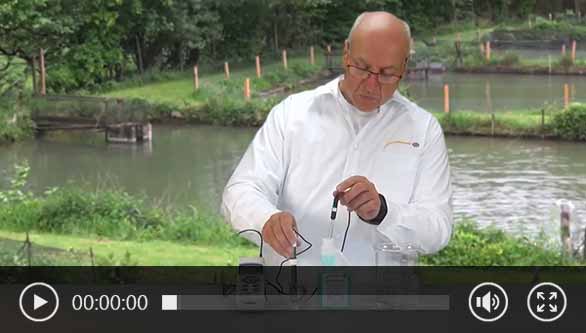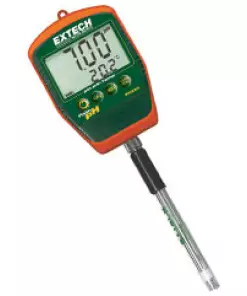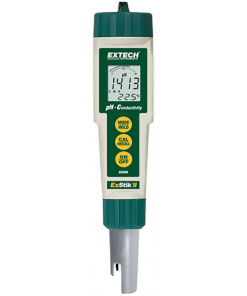pH Meter PCE-228LIQ for Beverages and Dairy Products
PCE-228LIQ
Availability : กรุณาติดต่อสอบถาม
PCE-228LIQ pH Meter for Beverages
For pH value, redox and temperature / Large, easy-to-read display / SD card memory (1 … 16 GB), stored data is saved as an Excel file / RS-232 interface and optional software for direct transfer to the PC
The pH meter for beverages PCE-228 is a very easy-to-use pH / mV / °C / °F handheld instrument. The pH value and the temperature can be stored directly on the SD card (Excel file) or transferred directly from the pH meter to a PC via the RS-232 interface. For this we optionally offer a software and the suitable RS-232 interface cable as an accessory. Temperature compensation is either manual or automatic via the supplied temperature sensor.
All this allows a fast and reliable pH measurement. The pH meter for beverages has a three-point calibration, which is performed automatically. It can be determined with the combination meter, the pH, the temperature or the REDOX potential (ORP). For the latter measurement parameters, however, a REDOX electrode must also be ordered. Here we recommend the ORP electrode ORP-14. The pH meter for beverages is battery operated (6 x 1.5V batteries are included).
Information about a pH meter for beverages
The variety of absolutely different beverages presented on the market today is overwhelming. What are the main means to get the attention of the customers? For sure, since more and more people strive for healthy and good quality products – “quality” occupies one of the top positions. Producers need to think not only about launching a new product, but about sustaining their reputation, therefore, permanent control and continuous monitoring of the production process is of pivotal importance!
From the commercials, we all know about importance of pH value, when it goes about water, skin, soap etc. What an interesting fact it is that pH plays an extremely important role in the beverages production too. Since pH value is a very good indicator of what is going on in the substance: whether it gets more acidic or alkaline, whether the necessary enzymes are active enough for the brewing process to take place (for example, beer), whether the dairy products are likely to preserve their quality, it is especially strictly monitored in the process of beverages, beer, dairy products production. The advantage of the modern meters is that they may be used in-line, which means they allow monitoring the process till the bottling moment. There are very high requirements to the devices (hygienic, temperature resistance, calibration, IP protection, resistance to contamination with food particles, reliability of measurements) which helps to reduce and exclude mistakes during the measuring process.
Maintaining correct pH level for each particular type of drinks and beverages means can carried out with the help of modern pH measuring devices.  It is also important to follow the requirements stated in the official Standards, to consider all the components and ingredients the drink consists of and pay attention to the processes going on in the product during its production (brewing, fermentation). Each particular product possesses its taste, flavor and shelf life. Drinking water, for example, has got a certain pH level which is considered to be desirable (between 6 and 8.5). Milk, for example, is always checked as an incoming product, since it should be fresh and its pH is changed correspondingly, depending on what product it is used for. When there are a few ingredients involved, pH level should be monitored in all of them. Production of beer, wine, yoghurt, milk products involves biological processes, when yeast, or special ferments are participating. pH here plays a crucial role, because its deviation from the desirable value leads to the deterioration of the quality and thus big loss for an enterprise.
It is also important to follow the requirements stated in the official Standards, to consider all the components and ingredients the drink consists of and pay attention to the processes going on in the product during its production (brewing, fermentation). Each particular product possesses its taste, flavor and shelf life. Drinking water, for example, has got a certain pH level which is considered to be desirable (between 6 and 8.5). Milk, for example, is always checked as an incoming product, since it should be fresh and its pH is changed correspondingly, depending on what product it is used for. When there are a few ingredients involved, pH level should be monitored in all of them. Production of beer, wine, yoghurt, milk products involves biological processes, when yeast, or special ferments are participating. pH here plays a crucial role, because its deviation from the desirable value leads to the deterioration of the quality and thus big loss for an enterprise.
If the pH level of beer (final product) is exceeding 6, this will mean that the whole batch has no chance for success among the customers, because the best pH value for beer is considered to be around 5.5. Wine with the pH level of 5.5 also is likely to disappoint the consumers and it is better to monitor pH level for a few times so that to reach a desirable level of 3-3.5. A real connoisseur of wine may give a full description of the drink by characterizing its color, flavor, viscosity, taste, aftertaste etc. Understanding as well as making good wine is a special art, that is why pH level is of crucial importance here. A little fluctuation within pH limits for wine is understandable, since there are white, red, dessert and sweet wines, but it should never exceed the desirable 3.5-3.6, so that the bacteria did not spread and spoil the sophisticated beverage.
Soft drinks and sparkling water and their impact on the humans’ health have been the topic for discussions for a very long time. To understand why is easy if to look at the pH level of these drinks. We have mentioned above the pH level of the potable clean water, and an interesting fact about sparkling water is that its pH level does not remain on the same level, but drops extremely (3 times less!), which means that sparkling water, as well as many carbonated soft drinks are rather acidic (sometimes with high sugar content) and, if consumed in big amounts, may cause various health problems, from heartburn and teeth problems to much more aggravating.
Some drinks, depending on what ingredients they contain, may have lower and higher pH level, and thus, be more alkaline or acidic. This relates to so popular nowadays smoothies! Due to a very high content of fruit or vegetables in it, the “character” of this type of drink may be influenced. Sweeter ingredient and sugar make the pH level lower, while, green vegetables, for example, will increase the pH level a lot and turn it into a very healthy drink.
Knowing pH level not only helps to monitor and keep the quality of the products under control and on a very high level, it also helps the consumers to select the beverages which taste, smell, look nice, but also which have a better impact on their health, and the producers to avoid problems with the batches of beverages and drinks, which cannot be sold on the market in the condition of very hard competition.
– Optimum price / performance ratio
– SD card memory (1 … 16 GB)
– The stored data are saved directly as an Excel file on the SD card (no software needed for evaluation)
– RS-232 interface for online Data Transfer
– Measures pH, ORP & pH. Temperature
– High accuracy
– Large LCD display
– Robust housing
– Incl. PH electrode PE-03 and stainless steel temperature probe
– Automatic calibration
– Manual or automatic temperature compensation
– BNC connector
– Suitable for laboratory and on-site pH measurement
– Additional REDOX electrode
– Adjustable measuring rate
– pH meter for beverages easy to operate
| Measuring range pH | 0.00 … 14.00 pH |
| Resolution | 0.01 pH |
| Accuracy | ± (0.02 pH + 2d) |
| Measuring range redox | -1999 … 0 … 1999 mV (only possible with optional REDOX electrode) |
| Resolution | 1 mV |
| Accuracy | ± (0.5% + 2d) |
| Measuring range temperature | 0 … 65°C / 32 … 149°F (only temp. Sensor) |
| Resolution | 0.1°C / 0.18°F |
| Accuracy (@ 20°C) | ± 0.5°C / 0.9°F |
| Calibration | pH meter for beverages has an automatic three-point calibration |
| Temperature Compensation | Automatically from 0 … 65°C / 32 … 149°F or manually between 0 … 100°C / 32 … 212°F with the temperature sensor removed |
| Electrode | pH electrode for eg beer, blood and milk products�/ BNC plug |
| Temperature range | 0 … 60°C / 32 … 140°F |
| Measuring rate | Adjustable from 1 second to 8 hours 59 minutes 59 seconds |
| Display | LC display 52 x 38 mm / 2 x 1.5 in |
| Data storage | Flexible via SD card memory 1 … 16 GB |
| Interface | RS-232 |
| Software | Optional |
| Power supply | 6 x 1.5V AA batteries / 9V power adapter (optional) |
| Environmental conditions | 0 … 50°C / 32 … 122°F max. 85% rh |
| Dimensions | 177 x 68 x 45 mm / 7 x 2.7 x 1.8 in |
| Weight | 490 g / 1.1 lbs |
เฉพาะลูกค้าที่เข้าสู่ระบบ และเคยซื้อสินค้าชิ้นนี้แล้วเท่านั้น ที่เขียนบทวิจารณ์ได้
สินค้าที่เกี่ยวข้อง
วัดออกซิเจนที่อยู่ในสารละลาย, pH, ความเหนี่ยวนำไฟฟ้า, TDS, ความเค็มและอุณหภูมิ
เครื่องบันทึกอุณหภูมิ
pH มิเตอร์ขนาดกระทัดรัดแบบแท่งพร้อมหัววัด pH
฿7,228.92 incl VAT
ประกอบด้วยหัววัด pH แบบแบน พร้อม Conductivity cell ที่มีย่านการวัดอัตโนมัติและมีความแม่นยำสูง
pH Meter
฿4,809.65 incl VAT












รีวิว
ยังไม่มีบทวิจารณ์